
solarseven/iStock via Getty Images
At the beginning of November 2022, the collapse of the FTX (FTT-USD) cryptocurrency exchange began, which with a high degree of probability will lead to the massive bankruptcy of its subsidiaries and will directly affect the mining company and other crypto exchanges. The events that the crypto industry has faced have shocked the entire world of finance and once again indicated the need for more stringent regulation to protect investors. The collapse of FTX was reminiscent of the events of February 2014, when Mt. Gox, the largest cryptocurrency exchange at the time, which accounted for about 70% of all Bitcoin (BTC-USD) transactions, had to suspend its activities as a result of cyber attacks that led to the loss of clients’ assets over $500 million. In the same year, the exchange declared bankruptcy, which only increased the distrust of people who viewed cryptocurrencies as an analog to traditional financial instruments. As a result, the price of Bitcoin fell by more than 80% in less than a year before the bottom was reached for this asset, followed by the start of a new bull cycle, drawing the attention of millions of people to cryptocurrencies around the world.
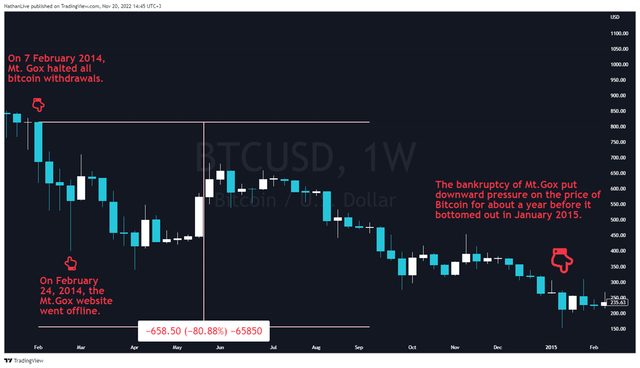
Source: N_Aisenstadt — TradingView
This article will provide an analysis of the impact of the FTX collapse on the financial position of other cryptocurrency exchanges and on the confidence of long-term investors in BTC, the risks of a domino effect, and the current state of mining and Bitcoin at a time of growing global macroeconomic and geopolitical problems that continue to kill investment interest in high-risk assets.
Before the collapse of the FTX cryptocurrency exchange
In mid-2021, FTX launched a series of investment products that allowed exchange customers to earn money by holding cryptocurrencies or fiat money in their deposit wallets under the “Earn Up to 8%” program. Relatively high-interest rates on deposits attracted hundreds of thousands of people, some of whom took out loans from banks to take advantage of such a generous offer. Given the increase in interest rates by central banks, rising inflation, and a decrease in interest in cryptocurrencies since the beginning of 2022, it was already becoming clear that the exchange could not legitimately give FTX customers such a high return. One of the last and most significant signals that FTX’s financial situation is far from ideal came eight days before the news of the suspension of withdrawals from the crypto exchange, when the company’s Twitter account announced the imposition of restrictions on the “Earn Up to 8%” program.

Source: Twitter account of the FTX cryptocurrency exchange
As a result of program policy changes, the maximum amount on deposit wallets that customers could earn income from was limited to $100,000, while the annual interest rate was also reduced from 8% to 5% if the balance exceeded $10,000.

Source: FTX
Many investors and traders were confident in the safety of storing their assets on the FTX crypto exchange, as its reputation was on par with Binance (BNB-USD). Sam Bankman-Fried, as CEO of FTX and one of the leaders of the cryptocurrency community, actively interacted with regulators in the United States and other countries to achieve recognition of cryptocurrency exchanges and the prospects for transactions with digital assets.
The current situation with FTX reserves
At the moment, the mechanism that led to the loss of deposits of FTX customers is not fully understood, but many investigations, including those published on Coindesk, indicate that Alameda Research played a key role in this. A significant portion of Alameda Research’s capital was held in FTT, which is FTX’s centrally controlled token. As a result, a company run by Sam Bankman-Freed could manipulate the value of this token by raising its price to use it as collateral as part of Alameda Research’s credit policy. However, following the disclosure of FTX’s financial difficulties, Binance’s desire to sell its holdings in FTT, and given the token’s low trading volume, resulted in FTT’s plummeting over 90%. As a result of FTT’s price drop, the value of the collateral depreciated, causing a liquidity crunch and eventually creating an $8 billion hole in the FTX cryptocurrency exchange’s balance sheet.
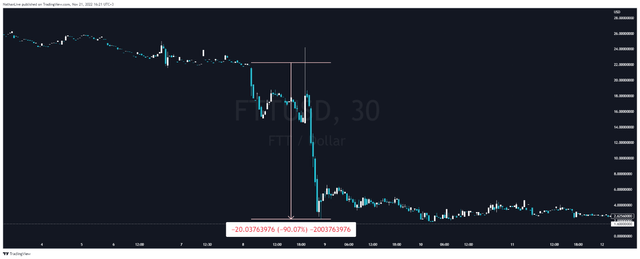
Source: N_Aisenstadt — TradingView
At the end of March 2022, the reserves of the FTX cryptocurrency exchange reached multi-quarter highs of more than 135 thousand Bitcoins. However, in the 2nd quarter of 2022, this indicator showed multidirectional dynamics, either rising sharply from the beginning, then declining by 47%. In September, the company’s reserves stabilized only for a short period, as if showing FTX customers that the financial position of the exchange is stable and that it is not worth fearing its bankruptcy. The stability of the company was fake, and from mid-September, its reserves continued to decline, and after the public disclosure of FTX’s problems, there were only 4,909 Bitcoins on the balance of the exchange. Although there is still no official report from the regulators, however, I believe that the collapse of Alameda Research and the emergence of FTX’s financial problems occurred as a result of the collapse of LUNA (LUNC-USD) in May 2022.
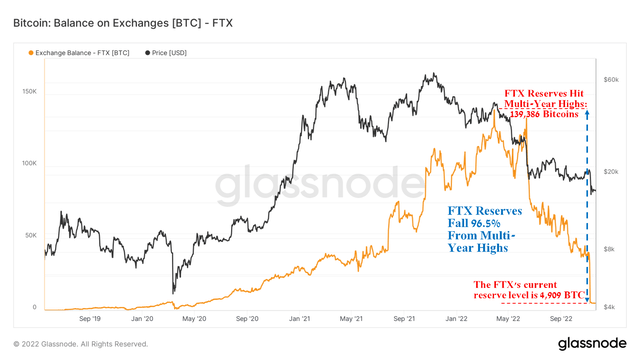
Source: Author’s elaboration, based on Glassnode
In addition to FTX’s Bitcoin and Ethereum reserves (ETH-USD), the cryptocurrency exchange also held reserves in stablecoins, whose combined value exceeded $1 billion at the beginning of February 2022. However, after that, stablecoin balances plummeted, thus giving the first signals of a certain depreciation of FTX’s balance sheet, which required the conversion of stablecoins to Bitcoin as collateral for loans. The most recent decline in the stablecoin balances occurred at the end of October 2022, when their combined value fell from $630 million to virtually zero in less than two weeks.
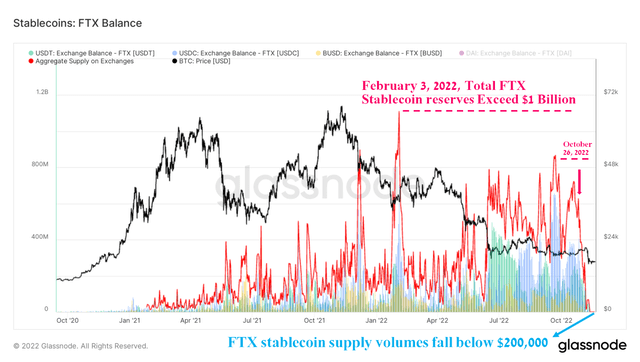
Source: Author’s elaboration, based on Glassnode
Before proceeding to the analysis of the price of Bitcoin, it is necessary to understand where investors withdraw their coins from FTX. Most market participants in the current period of uncertainty tend to choose a cold wallet as a place to store Bitcoin, Cardano (ADA-USD), Litecoin (LTC-USD), and other cryptocurrencies. The peak of the total balance of cryptocurrency exchanges was reached in 2020 when holders held about 3.2 million Bitcoins on them, but since then, the aggregate balance of BTC has only been declining. Over the past two months, there has been an enormous rate of withdrawal from exchanges as investors and traders seek to reduce the risks associated with holding digital assets on platforms, most of which do not conduct rigorous peer reviews of their accounting and financial statements. As a result of the collapse of FTX, the decline in the total balance of BTC continued to renew multi-year highs and, in my opinion, the market situation will continue for at least the next 2-3 quarters until the US regulators begin to pursue a tougher policy towards cryptocurrency exchanges.
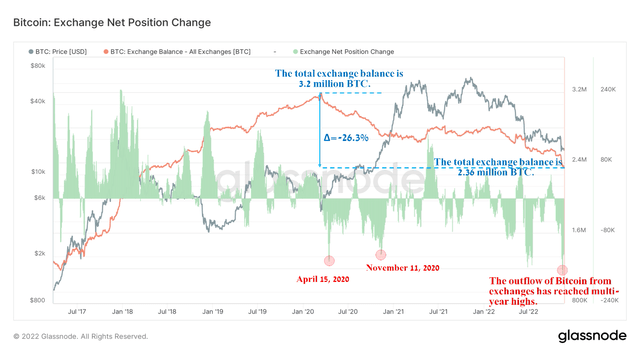
Source: Author’s elaboration, based on Glassnode
But despite the financial problems of the cryptocurrency exchange and the decrease in interest from investors, the Bitcoin hashrate continues to make new highs and is currently over 270 Exahash per second.
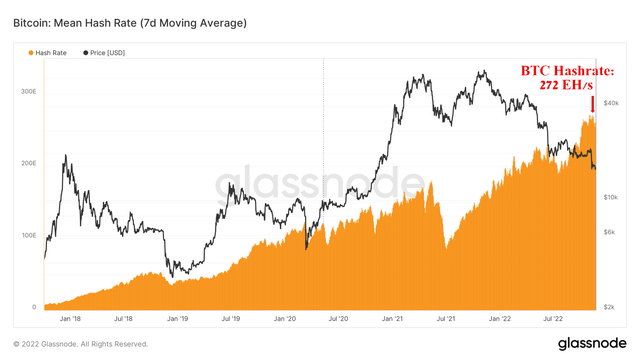
Source: Author’s elaboration, based on Glassnode
The pressure on the crypto industry is exerted by the fact that Ethereum mining stopped at the end of the 3rd quarter of 2022, thereby reducing the interest of potential market participants in investing in cryptocurrencies. As a result, I expect that the outflow of investment interest from the industry will continue, which will also negatively affect Nvidia (NASDAQ:NVDA) and AMD (NASDAQ:AMD), whose video cards were massively used to mine the second most important cryptocurrency.
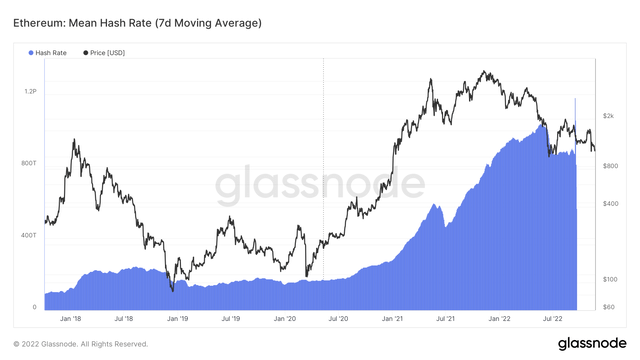
Source: Author’s elaboration, based on Glassnode
With BTC’s current price of $16,000, the largest investors holding more than a thousand Bitcoins in their accounts experienced unrealized losses of more than $1,800 per Bitcoin for the first time since 2020. As a result, this is unprecedented for the industry and may reduce their desire to invest in cryptocurrencies until the macroeconomic situation improves. On a larger scale, the financial problems of smaller investors also continue to worsen, as reflected in the sharp jump in realized losses over the past three years. So this week, there was a peak daily realized loss of over $1.4 billion. As a consequence, this indicates that investors continue to close their losing positions and withdraw their money from the market.
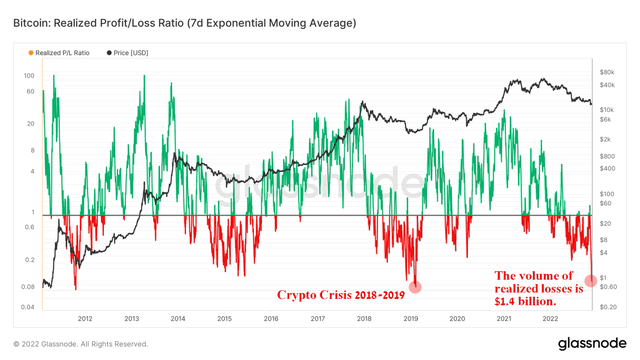
Source: Author’s elaboration, based on Glassnode
Moreover, one can observe a decrease in Bitcoin trading volumes in the futures markets, which have reached multi-year lows and are currently at $16 billion per day. As a consequence, this signals low liquidity in the trading environment, which could increase downward pressure on the price of BTC with momentum to the price range indicated in my bearish article imminently.
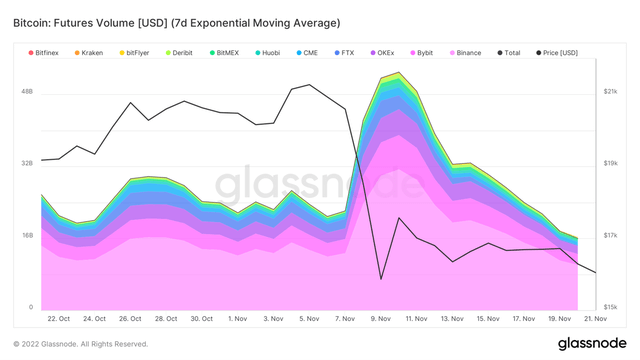
Source: Author’s elaboration, based on Glassnode
Conclusion
Since the end of October 2022, when my article about the prospects of the crypto industry was published, the price of Bitcoin has already fallen by more than 25%, which is somewhat higher than my expectations for the rate of its decline and the main reason for this is the collapse of the FTX cryptocurrency exchange.
The collapse of FTX dealt a severe blow to the industry and attracted the attention of US regulators, who will seek to tighten regulatory policies to make such situations less and less common. Unfortunately, this terrible event undermined the confidence of potential investors in cryptocurrencies. Until all the details of FTX’s relationship with Alameda Research are revealed, this will continue to poison the entire industry, and the recovery period will take longer than in previous crises.
During the current crypto crisis, I expect that many exchanges, including Coinbase (COIN), will continue to lose customers, which will lead to a decrease in trading volumes with a subsequent deterioration in their financial situation in the coming quarters. As a consequence, the collapse of FTX will not only have a negative impact on the crypto industry, but will also directly affect Cathie Wood’s Ark Invest, who has invested in crypto companies.
From the point of view of technical analysis, the price of Bitcoin is in a bearish trend and continues to move within the correctional wave IV. The current price of “digital gold” has a negative impact on mining companies such as Riot Blockchain (RIOT), Hut 8 Mining (HUT), which in my opinion are highly likely to resort to issuing new shares to finance their activities and buy equipment to maintain the current volume of bitcoin mining. The reasons for this are that the sale of mined coins by these companies has been happening at a price below the cost of Bitcoin for more than two months, and at the same time, network difficulty continues to grow due to increased competition in the mining industry.


Be the first to comment